
Mathematical ImageryMathematical artists create strong, stunning works in all media and explore the visualization of mathematics
2011 Mathematical Art Exhibition
The Mathematical Art Exhibition held at the 2011 Joint Mathematics Meetings in New Orleans, included juried works in various media. Robert Fathauer was the curator of the exhibition, and the exhibition website was prepared by Anne Burns. The 2011 Mathematical Art Exhibition Awards were awarded: First Place to Margaret Kepner, for her work, "Magic Square 25 Study"; Second Place to Carlo Sequin for "Torus Knot (5,3)"; and Third Place to Anne Burns for "Circles on Orthogonal Circles". The Award "for aesthetically pleasing works that combine mathematics and art" was established in 2008 through an endowment provided to the American Mathematical Society by an anonymous donor who wishes to acknowledge those whose works demonstrate the beauty and elegance of mathematics expressed in a visual art form.
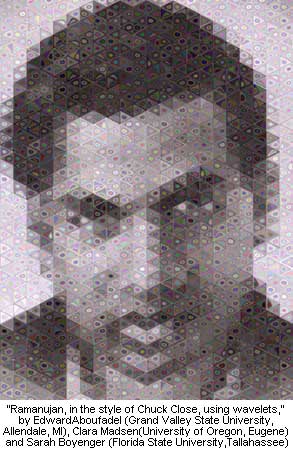
Digital print, 16" x 20", 2009. Both the subject of this work and the method of creation are intricately mathematical. Ramanujan is the famous 20th century Indian mathematician who established or conjectured a broad collection of results in number theory. He caught the attention of Hardy, who recognized Ramanujan's genius. To create this digital image in the style of Chuck Close, wavelet filters were used to detect the existence and orientation of edges in the original image, and other calculations were made to determine the colors in the "marks". --- Edward Aboufadel, Clara Madsen, and Sarah Boyenger
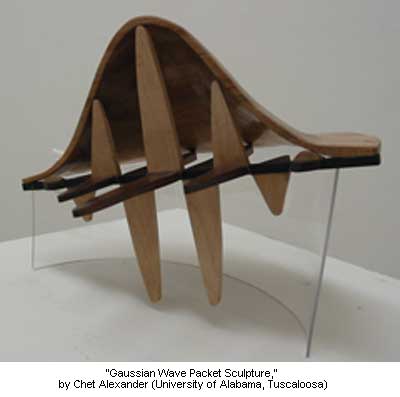
Wood (birch, walnut, maple, ebony), 9" x 11" x 10", 2006. Mathematics of the Wave -Packet Sculpture: In this sculpture, mathematics was used to calculate the Gaussian wave-packet model of a particle in quantum mechanics. This is accomplished by forming a linear combination of plane waves of different wave-numbers, $k$. A particle with mass and momentum $p$ can have wave properties as described by the de Broglie wavelength relation $\lambda =h/p$. The Gaussian wave packet model is a way to combine the wave and particle properties of a particle of momentum $p=hk$ localized at position $x_0$. The probability of finding the particle at position $x_0$ is given by the probability density of the particle as $|\psi(x,0)|^2 \sim \exp[-(x-x_0)^2/(2(\delta x)^2)]$ , and by a Fourier transform the probability density of the particle's momentum can be written $|\psi(k)|^2 \sim \exp[-(k-k_0)^2/(2(\delta k)^2)]$. The wave packet sculpture presents a Gaussian wave packet envelope and an electromagnetic wave enclosed in the envelope. --- Chet Alexander
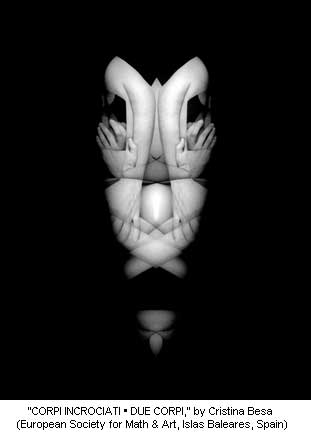
6 x 7 negative, print on Ilford glossy paper, 12" x 16" (framed 20" x 24"), 2004. Bilateral symmetry--a combination of identical exposures intersecting with their own reflections. The intersection of the two shapes A (original) and B (reflection of A) are positioned at the same angle to create a new form bound by its central line reflection. --- Cristina Besa

Wood (maple) and steel, 3" in diameter, 2010. Inspired by my favorite childhood toy, a ball labyrinth game made by Brio, I hand carved a symmetric simple closed curve into the surface of a 3" diameter ball of maple. The curve is a channel that is deep enough and wide enough to hold a 0.5" diameter ball of steel. It is possible to pick up the ball of wood and maneuver it so that the ball of steel will roll through the entire channel and end up back where it started. --- Robert Bosch
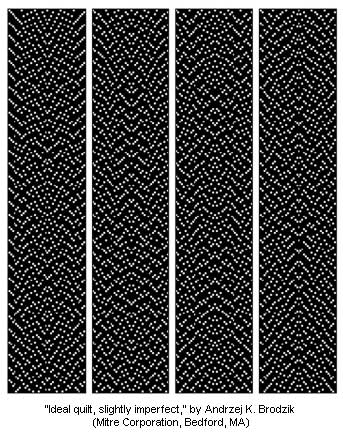
Digital print, 24" x 20", 2010. Ideal quilts are Zak space representations of families of ideal sequences. Ideal sequences are sequences with certain special group-theoretical properties. In particular, ideal sequences satisfy the Sarwate bound, having both zero out-of-phase autocorrelation and minimum cross-correlation sidelobes. Construction of ideal sequences was described in the recent book, Ideal sequence design in time-frequency space. Ideal quilts are $(p-1)p$ by $(p-2)!p$ images, where $p$ is a prime. As these images tend to be long and narrow, to facilitate display, they are usually divided into columns. Geometrically, an ideal quilt is a sequence of distinct permutations of the canonical image of a diagonal line. Both the overall structure of the image and the association with ideal sequences convey a strong sense of symmetry, predictability, and uniqueness. To counter-balance these qualities, the corrupting effect of tiff data compression, manifested as pixel distortion, is embedded into the image. --- Andrzej K. Brodzik

Rapid prototyping sculpture, 200mm x 60mm x 60mm, 2010. This is a visualization of a tiling of the hyperbolic space. The tiling is generated by reflections in the faces of Lambert cube (Coxeter polyhedron), which becomes the fundamental polyhedron of the symmetry group of the tiling. Only 4 out of 6 sides are used, which results in sub-tiling (subgroup) filling only part of the space. It let us see the internal structure of the tiling. We use a cylinder model of the hyperbolic space--a 3D generalization of 2D band model. In this model the Poincare ball is stretched into infinite cylinder. Cylinder's axis becomes one of hyperbolic geodesics. The tiling is oriented to make one it's plane to be orthogonal to the cylinder's axis to have a feet to stand on. The cylinder's axis is close to the axis of a loxodromic transformation of the group, which gives the pieces its spiral twist. The sharp boundary of the piece corresponds to the limit set of the group. The limit set is fractal Jordan curve at the infinity of the hyperbolic space. --- Vladimir Bulatov
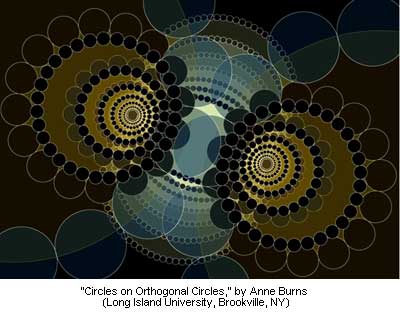
Third Place Award - 2011 Mathematical Art Exhibition
Digital print, 12" x 16", 2010. A loxodromic Möbius transformation has two fixed points, one attracting and the other repelling. Starting with a small circle around the repelling fixed point, and repeatedly applying the Möbius transformation, results in a family of circles that grow at first, each containing the previous one. Successive images eventually pass over the perpendicular bisector of the line connecting the fixed points and shrink as they are attracted to the other fixed point. Each circle in a second family of circles passes through the fixed points and is mapped to another circle in that family. Each circle in the second family is orthogonal to every circle in the first family. --- Anne Burns

Giclee print on watercolor smooth paper, 12" x 15", 2007. MacDuff's Shield depicts the shield and spirit of the character MacDuff in Shakespeare's play, "Macbeth." The shield is constructed from two superimposed copies of a texture taken from a Julia set and styled for this purpose. This composite was then laid upon a surface of revolution to complete the shield. The ethereal veil in which the shield floats presents the idea that MacDuff is "not of woman born." This veil was created by orbit-trapping in the interior of the Mandelbrot set. --- Robert A. Chaffer
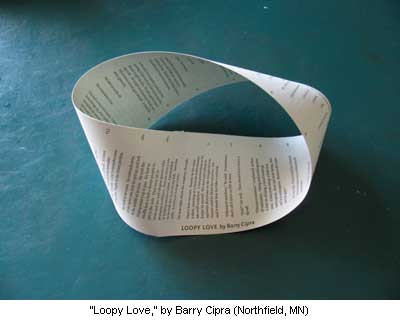
Letterpress print on paper, 11" x 6" x 5", 2010. "Loopy Love" was composed for a workshop on Creative Writing in Mathematics and Science, held at the Banff International Research Station (BIRS), May 2-7, 2010. The idea was to explore the implications of writing a short story on a möbius strip. The story, a dialog presenting both sides (or is there only one side?) of a twisting love/hate relationship between two characters named Daniel and Danielle, was letterpress printed by Red Dragonfly Press in Red Wing, Minnesota, on Fabriano paper using the font FF Quadraat. Assembled by hand with tape, the resulting scrollable sculpture retains its shape yet remains flexible, so that the reader can easily read the story without ever having to turn the page. Viewers are invited to pick it up, play with the paper, and read the story from start to finish--except there is no start, nor any finish! --- Barry Cipra
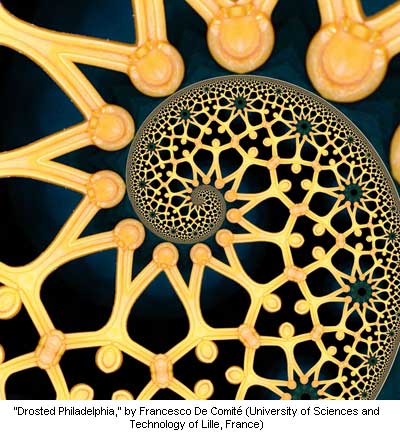
Digital picture, 30x30 cm, 2009. Drosting, a hyperbolic tiling. Manipulation of digital images and use of ray-tracing software can help you to concretize mathematical concepts, either for giving you an idea of how a real object will look, or to represent imaginary landscapes. --- Francesco De Comité
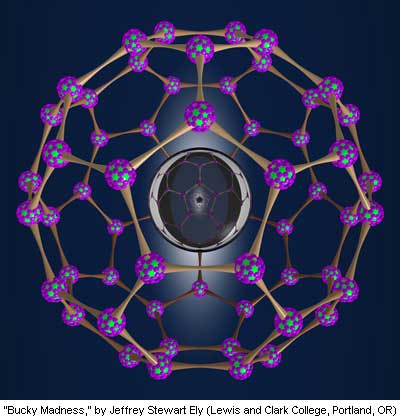
Digital print on archival paper, 20" x 20", 2010. This is my response to a request to make a ball and stick model of the buckyball carbon molecule. After deciding that a strict interpretation of the molecule lacked artistic flair, I proceeded to use it as a theme. Here, the overall structure is a 60-node truncated icosahedron (buckyball), but each node is itself a buckyball. The center sphere reflects this model in its surface and also recursively reflects the whole against a mirror that is behind the observer. I was recently surprised to read in David Richeson's book, Euler's Gem, that Legendre proved Euler's Formula, V - E + F = 2, by projecting a polyhedron onto a sphere and then summing the areas of the various spherical polygons. I think this fact resonates rather well with this design. --- Jeffrey Stewart Ely
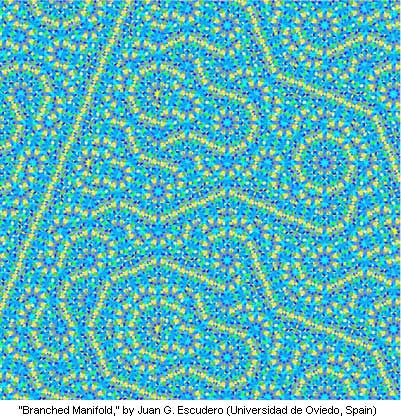
Digital Print, 20" x 20", 2010. A cell complex is defined in the analysis of the cohomology of tiling spaces. It contains a copy of every kind of tile that is allowed, with some edges identified for the 2D case, and the result is a branched surface. When the tiling does not force the border, collared tiles can be used. Here the triangles with the same shape, color and orientation represent the same tile in the complex. The manifold appears in the cohomology computations of an octagonal pattern belonging to a random tiling ensemble introduced by the author in the context of mathematical quasicrystals. --- Juan G. Escudero
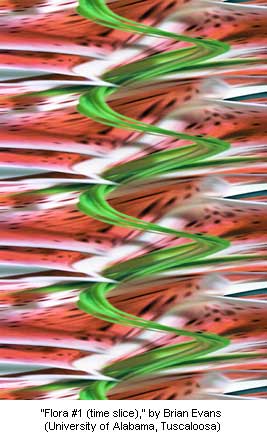
Archival inkjet print, 9" x 6" (14" x 11" framed), 2010. How much is lost in the reduction of reality to human sensation. The infinite detail there in front of us is reduced to 100 million discrete measurements made with the rods and cones on the retina of the eye. Infinity reduced to 100 million, which is reduced another ninety-nine percent as the signal is compressed to travel only 1 million pathways on the optic nerve. It's a wonder we can make sense of the world at all. These little photos are also reductions, slit-scans of flowers rotating on a tabletop 2D slices of time. The four dimensions of our reality (x, y, z, t) are reduced to two (x, t) showing a different aspect of the real. The temporal is mapped into the static and new forms and structures are seen. These works are metaphors for the language of mathematics. What wonders we can discover through the processes of abstracting, reducing, mapping, and finally looking in new ways at the little slices of information we receive from all the surrounds us. --- Brian Evans
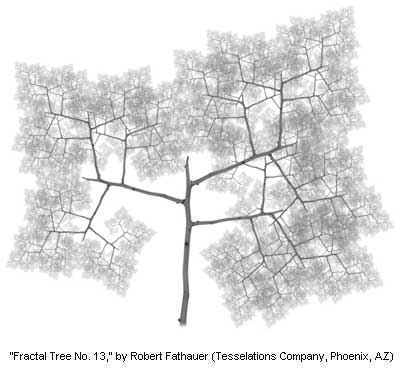
Digital print, 13" x 16", 2010. "Fractal Tree No. 13" is a black-and-white digital artwork constructed by graphically iterating a photographic building block. Several photographs of a small portion of a palo verde tree were combined and digitally altered to create the building block, which allows smooth joining of smaller copies to larger copies. In addition to being scaled down, the three smaller copies, added with each iteration are rotated by varying angles, and one is reflected as well. A sufficiently large number of iterations were performed so that the image is indistinguishable to the eye from the image that would result after an infinite number of iterations. In this particular tree, the iteration rules result in considerable overlap of the branches, leading to a complex collection of small features reminiscent of pencil marks. The fractal shape of the envelope of these features didn't emerge until approximately one dozen iterations were performed. --- Robert Fathauer

Bead weaving with crystal, glass and metal beads, and thread, 12 beads, longest diameter ranges from 11 mm to 33 mm, 2010. The Ionic Polyhedra are part of my larger body of mathematical artwork in beaded beads. A beaded bead is a cluster of smaller beads, woven together with a needle and thread, to form a composite cluster with one or more holes running though the center of the finished beaded bead. To make these beads, I started with inner cluster of beads in two sizes where the larger beads are aligned on the edges of polyhedra. For the larger six beads, I added layers of seed beads, which emphasize the edges of the underlying polyhedra. Although they appear different, the miniature version of each Ionic Polyhedron maintains the same structure and thread path as its larger version, but the beads are smaller, and the embellishment is simpler. Represented are the octahedron, cube, pentagonal dipyramid, pentagonal antiprism, cuboctahedron, and rhombic dodecahedron. This coloring of the miniature cuboctahedron and rhombic dodecahedron illustrates the dual relationship between these two polyhedra. --- Gwen Fisher
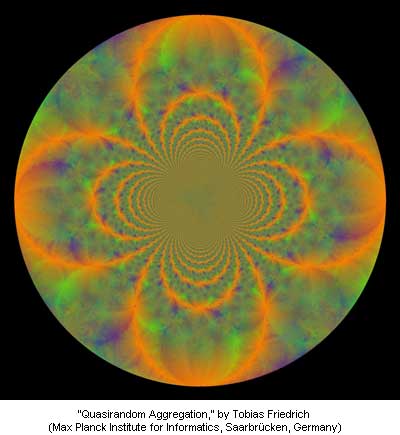
Digital print on glossy paper, 20" x 20", 2010. Given an arbitrary graph, a random walk of a particle is a path that begins at a given starting point and chooses the next node with equal probability out of the set of its current neighbors. Around 2000, Jim Propp invented a quasirandom analogue of random walk. Instead of distributing particles to randomly chosen neighbors, it deterministically serves the neighbors in a fixed order by associating to each vertex a "rotor" pointing to each of its neighbors in succession. The picture shows what happens when one billion particles are placed at the origin and each one runs until it reaches an unoccupied vertex. Black pixels denotes cells that never get visited by a particle; for the other cells, the color of the pixel indicates in which direction the rotor points at the end of the process. See more information. --- Tobias Friedrich
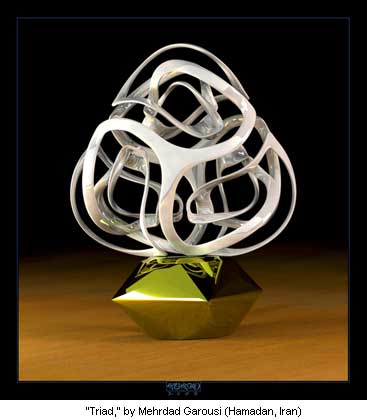
Digital print on canvas, 18" x 16", 2009. This work created in TopMod comprises a uniform twisted strip with some ties and joints. The shape containing an evident three-fold rotational symmetry is composed of three similar components connected at two central joints placed back and forth. The outstanding issue is another hidden symmetry, which may not be discovered at a hasty glance. In addition to the former symmetry, condoning back and forth or up and down position of layers, as a flat plane, the whole sculpture has a three-fold mirror symmetry. The reason of such a property is the same one-fold mirror symmetry governing each of the three components. --- Mehrdad Garousi
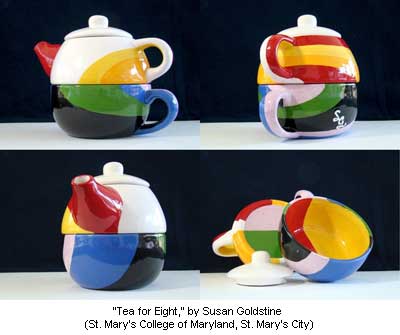
Glaze on commercial ceramic, 5" x 8" x 5", 2010. The Four-Color Theorem says that we can color any map on a plane or sphere with only four colors so that no neighboring countries are the same color. On other surfaces, we may need more colors; on a two-holed torus, eight colors are sufficient, and there are maps that require all eight colors. When this tea set is stacked with the handles aligned, it forms a topological two-holed torus with a map of eight countries, each of which touches all of the others, proving that eight colors are necessary. The teapot has white, red, orange, and yellow countries, and the teacup has black, green, blue and purple countries. At the seam between the pieces, each of the top colors touches each of the bottom colors. On one-holed tori, such as the teapot and the teacup, seven colors are required for an arbitrary map. Unfortunately, a seven-color map is incompatible with the tea set's exterior pattern; when the tea set is opened, hidden colors give six-color maps of the teacup and the teapot. --- Susan Goldstine

Fine silver, copper, 1.5 x 1.5 x 0.25 inches each (2 brooches), 2009. These brooches were inspired by my undergraduate graph theory research into the colorability of the map created by a finite tiling of circles in the plane. I was able to prove by mathematical induction that the resulting map is 2-colorable. This result lends itself quite well to the process of married metals. Two pieces of metal were overlaid: one copper and the other fine silver. The design was pierced from both sheets at once, and alternating pieces were swapped to form the two 2-colored designs. The individual components of each image were silver-soldered together, and the sides and back of each brooch hollow constructed to create the final form. The process yields two images, each one the inverse of its partner. To emphasize the complementary nature of each image, I fabricated one brooch with a convex face and the other concave. --- Anansa Green
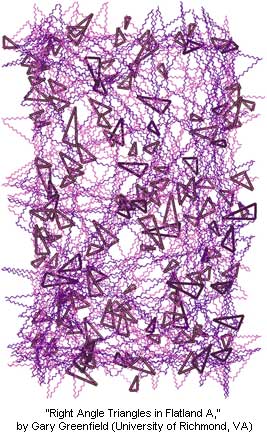
Digital print, 18" x 12", 2010. Four Flatlanders are sweeping through Flatland celebrating their discovery of how to draw right triangles. Their method is as follows: (1) pseudorandomly generate a turning angle $\alpha$ and an adjacent side length $x$; (2) calculate the complementary angle $\beta$ and use trigonometry to calculate the opposite side length $y$ and hypotenuse length $h$; (3) then swivel right, forward $x$, turn $\alpha$, forward $h$, turn $\beta$, forward $y$, swivel left. These Flatlanders belong to the caste required to "wag" from side to side when they walk. Thus they defy convention by drawing perfectly straight thick lines when presenting their right triangle discovery. Here, Flatlanders are implemented as simulated drawing robots obeying obstacle and collision avoidance, and their wag is implemented by making one of their pens swing side to side in such a way that a sinusoidal track is drawn as they make their through Flatland. --- Gary Greenfield
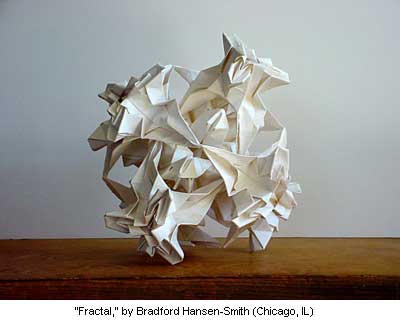
Folded 9" paper plates, 8" x 8" x 8", 2009. This is formed using twelve 9" paper plates all folded to the same equilateral triangular grid and reconfigured to the same design with slight variation between the four units that make the center tetrahedron pattern and the eight circles that form the outer cubic arrangement. This is one of many explorations using fifty-four creases rather than the twenty-four creases I usually work with. The higher frequency triangular grid allows greater complexity in a single circle which when combined in multiples forms designs that would not be possible otherwise. --- Bradford Hansen-Smith

Video, 19" flat panel monitor (about 18" by 12"). "Chaos - The Movie" is a stop-motion animation movie in which I create a line drawing based on Chaos Theory. The drawing--and the movie--were made over a period of six months. Music is an original composition made for the movie by Max Schreier. Meejin Hong did the video editing. --- Susan Happersett
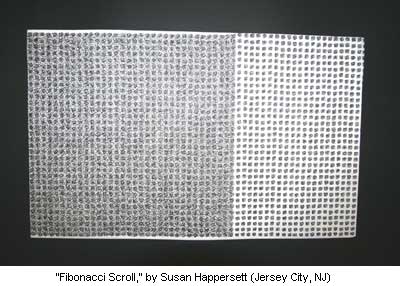
Video, 19" flat panel monitor (about 18" by 12"), 2010. Fibonacci Scroll is a stop-motion animation of a long scroll drawing based on the Fibonacci Sequence. Susan Happersett has been creating mathematical, counted marking drawings for a number of years, but this is the first time her markings come to life. The sound track was composed specifically for the movie by Robert van Heumen, an accomplished composer and musician. --- Susan Happersett

Nylon (selective laser sintering), 6" x 6" x 6", 2009. "Ball and Chain" is a ball made of triangular chain mail mesh containing twelve flexible regions in a rigid dodecahedral framework. There are 3,722 small rings, which interlock to form a sphere with chiral icosahedral symmetry. At 920 places, six triangles meet, but at 12 special points (at the center of the twelve dimples) only five triangles meet. The ball does not collapse down to a disk because the dodecahedral structure of ribs (made by having some of the rings lock to form a skeleton) is rigid. But in twelve circular regions the rings are free to hang freely. No matter how it is turned, the top six regions hang to make concavities while the lower six regions are convex and blend in with the overall spherical form. The complete structure was created as one unit in its assembled state by selective laser sintering. --- George Hart
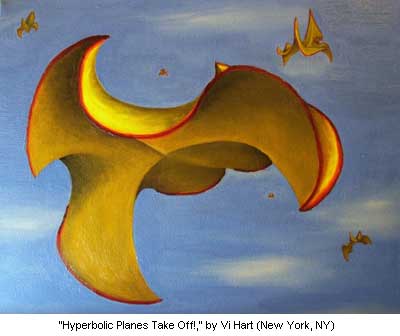
Oil paint on canvas, 20" x 16", 2010. What does it look like when you crease the hyperbolic plane? This painting is an attempt at visualizing simple origami done with hyperbolic paper. Each plane has a mountain and valley fold perpendicular to each other. Done with your average Euclidean sheet of paper, it would be impossible to have both creases folded at a non-zero angle, but the hyperbolic plane can fold both ways at once. The creased plane can then be manipulated into different "birds", or so I imagine. --- Vi Hart
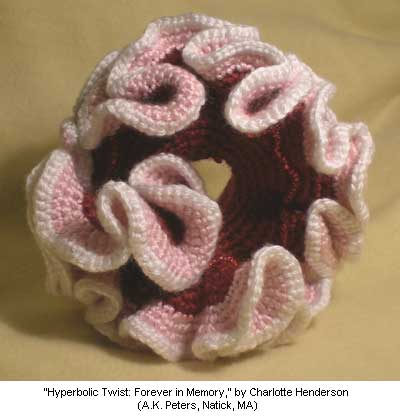
Acrylic yarn and glass beads, 6 × 6 × 4 inches (3d work), 2010. This model is a hyperbolic Möbius band. The starting ?spine? consists of 20 chain stitches, and the outer single edge has over 1600 single crochet stitches. The negative curvature of the surface allows the width of the band to be much greater than if the curvature were zero. The surface can move freely through the ?hole? in the center. The bead work highlights the nonorientability of the surface. In isolated sections, it looks as if the beads are on two sides of the band; but if one traces the line of beads, one will return to the chosen starting point having traced all of the beads. The same amount of yarn is used for the red and the pink, to display the exponential growth of the surface. (There is a greater amount of white yarn, to have a constant final row for aesthetic purposes.) The color scheme arose from the fact that, at an earlier construction stage, the silhouette of the model resembles a heart. --- Charlotte Henderson
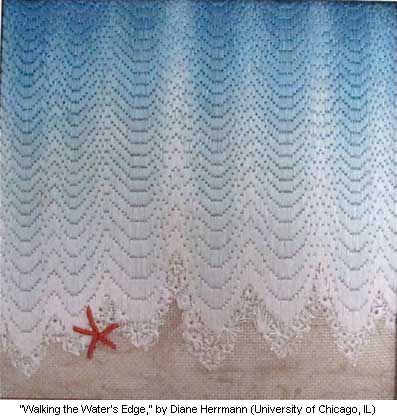
Needlepoint on canvas, 14" x 14", 2009. In this piece, the line imitates the edge of a wave on the shore. To make this wave look realistic, we used a mathematical curve that models the way a wave breaks on the beach. To be mathematically precise, we work with the sum of two trigonometric curves to show the action of water as it sloshes over itself in the push to get on the shore. The graph that defines the line of the Florentine Stitches is a close approximation to the curve: $ f (x) = 5 \sin x + 4 \cos (2x + \pi/3)$. The technique of thread blending creates the shading of the wave. Freeform eyelet stitches mimic the foamy edge of the wave and beads add sparkle. A single starfish is added in Bullion Knots. --- Diane Herrmann
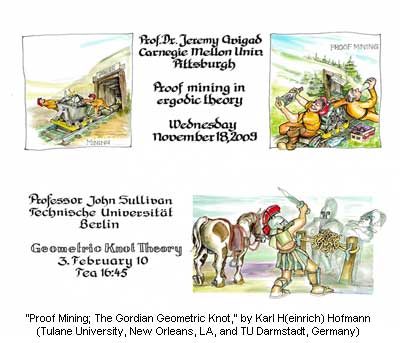
Pencil, felt pen, tempera, 20" x 24", 2009. Two artworks from the Darmstadt Colloquium Poster Project, framed together. The techniques used are pencil, felt pen, tempera. The calligraphy of the posters is obtained with a Copic felt pen in a typography specifically developed for this purpose. The texts are prescribed by the departmental colloquium program determined one semester in advance. A complete collection of scans of the last 12 semesters can be inspected on my website. --- Karl H(einrich) Hofmann

Digital print on paper, 420 x 420 mm, 2010. The graphics shows the plot of the zeros of the Jones polynomials of rational knots and links up to n=17 crossings, where zeros of knots are red, and zeros of links are yellow. --- Slavik Jablan
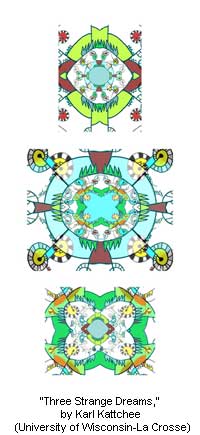
Digital print, 24" x 12", 2010. This is derived from one of my other works---"Rings and Monoids"---by tiling the plane with it, capturing three close-ups, and weaving them together to create these three images. The viewer is invited to attempt reconstructing "Rings and Monoids" or to visualize a looping animation composed of these three frames. Or not, if you prefer. --- Karl Kattchee
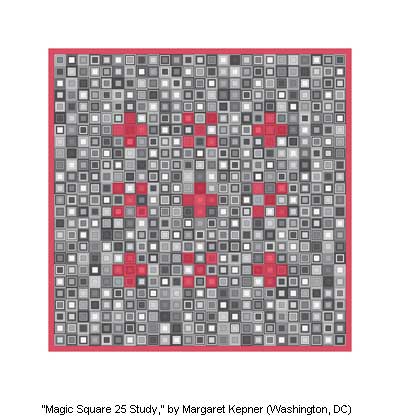
First Place Award - 2011 Mathematical Art Exhibition
Archival inkjet print, 12.5" x 12.5", 2010. Magic squares are numerical arrays that have substructures with constant sums. This design is based on a magic square of order 25, containing the numbers from 0 to 624. Each row, column, and main diagonal sums to the "magic constant" of 7800. The numbers in the magic square are represented by a visual base-5 system: four concentric squares serve as the 1, 5, 25, and 125 places, while shades of grey stand for the numerals 0 to 4. Coding the numbers into their base-5 versions yields a pattern of 625 unique, nested-squares in shades of grey. This particular magic square also has a substructure of 25 mini-squares of size 5. Each of these mini-squares is “magic” (although the numbers are not consecutive), with rows, columns, and diagonals summing to 1560. In addition, certain other groups of 5 squares add up to 1560. Examples are the quincunx and the plus-sign shapes (when fully contained in a mini-square). The colored accents are used to indicate a few of these "magic" substructures. --- Margaret Kepner

Print, 300 x 250 mm, 2007. Hexagonal fractal creates this terrace-like surface that imitates exotic terrain, which has architectural implication. The triangular fractal formations occasionally occur amongst rather random surface. --- Ghee Beom Kim
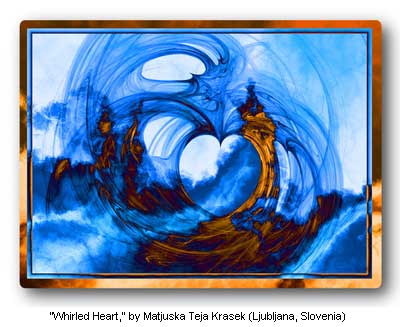
Digital print, 170 x 230 mm, 2010. In the mysterious world of chaos and strange attractors a seeker can find very heartful things. --- Matjuska Teja Krasek
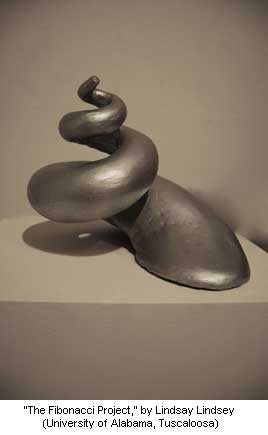
Cast aluminium, 18" x 18" x 16", 2010. The sculpture is based off the mathematical concept of the Fibonacci sequence and the spiral found in the Nautilus shell. In order to accurately construct a three-dimensional spiral that has the specifications of the Fibonacci sequence, special attention had to be paid to the size of the sculpture. At specific intervals along the sculpture, the diameter of the sculpture accurately increased with respect to the Fibonacci sequence. The intervals along the sculpture were also planned out using the sequence as a guide to the ever-increasing segments. The turns of the spiral were calculated using the Nautilus shell as a guide. Their increasing diameters are directly proportional to the diameter of the shell. Throughout the construction process, various checks were made to insure that the sequence was being preserved. The sculpture has truly become an accurate three-dimensional representation of both the sequence and the spiral. --- Lindsay Lindsey
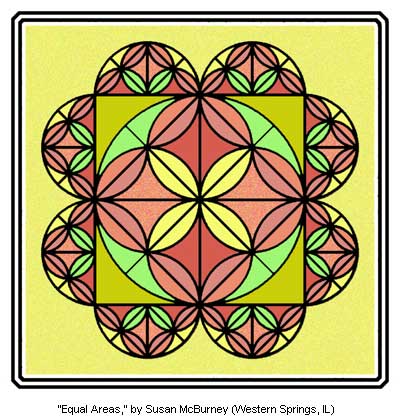
Digital print, 12" x 12", 2010. This artwork was inspired by two pages from Leonardo DaVinci's notebooks. While these magnificent books are legendary for their beauty of illustration and depth of subject matter, his purely geometric diagrams have been dismissed by some as intellectual doodling. Closer inspection reveals that at least some of them highlight the equality of different-shaped areas. "Equal Areas" builds upon that concept to also include relative areas of similar figures. In particular, those areas of a certain color in the border design are equal to the same-colored areas in the central figure. All light yellow areas in the borders add up to the all the yellow areas in the center, etc. Note that in some cases the shapes of the same colors are different, yet they are still equal in area. --- Susan McBurney
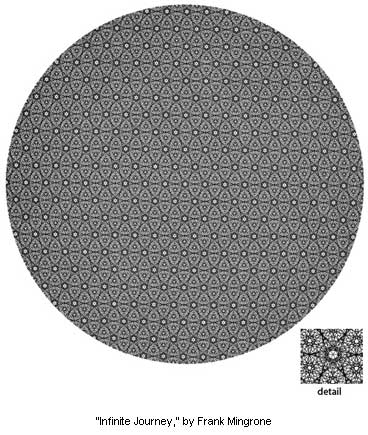
Poster (scan of hand ink drawing on paper), 32" x 24" (original 45" x 42"), 1985. There were no computers used in the creation of this drawing. It was completely hand drawn using a pen and ruler and consists of straight, unbroken, parallel lines that extend to the outermost perimeter. If the perimeter expanded and the lines repeated and extended, the symmetrical pattern would continue infinitely. The use and placement of straight lines are not a random guess but must conform to a mathematical framework for their representation. Each group of lines is analogous to a group of integers, and it is the exact arrangement of the lines arising from balanced proportions that create the intricate patterns. The lines can flow in a successive order, or, with varied intricate combinations. The singularity of straight lines unites a complex system of multiple interrelated sections creating the illusion of curvature. The various parts relate to the whole and the patterns grasped and visualized as a whole. --- Frank Mingrone
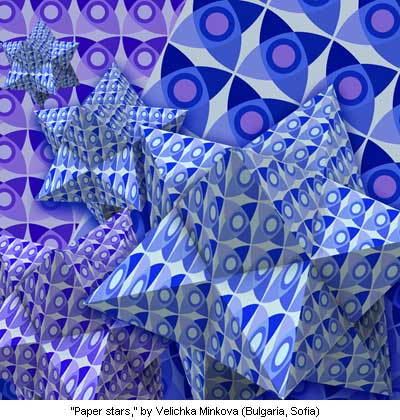
Digital C, 18 "x 18", 2010. Law is offered at a symmetry in proper square network and her use at making abstract constitution by a volumetric-plastic forms. --- Velichka Minkova
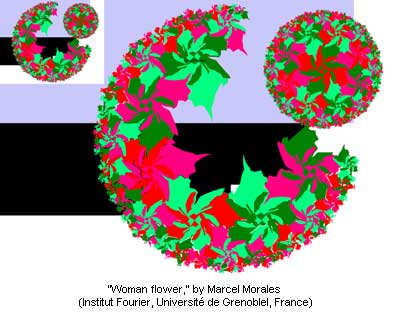
Digital print on canvas, 300 x 450 mm, 2010. I use hyperbolic geometry, in fact the idea of tiling the hyperbolic plane, to produce a tile such that by repeating hyperbolic rotations we can fill the plane. In this artwork a difficult point is to find the tile. My idea is to use a woman to fulfill a flower, and this flower fulfills the moon and the earth, changing colors and getting maturity. --- Marcel Morales
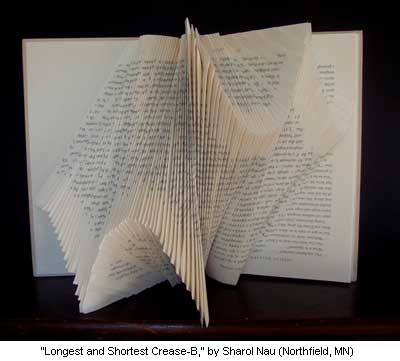
Folded book, 12.5" x 9” x 6", 2010. For this book-sculpture of several hundred pages, the shortest crease was obtained by folding the pages without separating them from the binding. Also the folding process began in the middle in an effort to achieve a symmetrical design. --- Sharol Nau
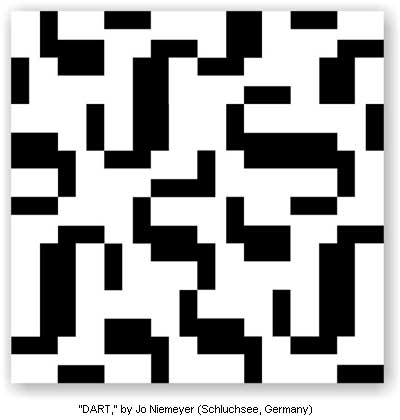
Archival inkjet print, 20" x 20", 2010. DART ... as a very simple game by Jo Niemeyer 2010 . Two dart players, A and B, are facing this "image", whose area is split 1 : 0.618.. into white and black. This two basic elements are rotated in 90° increments. The winner is, who aims first a black part. Since we have two equal partners and an uneven distribution of the "target", one would think, that this is not a fair game. But it is! Because A as the "majority", and consequently B as the "minority", transferred their inequality onto the "court." The ratio of the two playing partners is 1:1. With this harmonious proportionality there is exactly the same chance to win for both players A and B! The Swiss mathematician Hans Walser mentions for the justice condition, the formula $p = 1/2*(3-\sqrt{5})$. And with $\sqrt{5}$, we have the golden section in this game, which ensures equity between different partners. This is also a very fair game! Or a piece of art, which ensures harmony and balance. --- Jo Niemeyer

Counted cross stitch on fabric (25 count per inch), 13.5" x 13.5", 2009. The Sierpinski Triangle is a fractal that can be generated by dividing a square into four equal subsquares, removing the upper right subsquare, and then iterating the construction on each of the three remaining subsquares. That is our "Theme", shown in the upper left. The “Variations” arise by exploiting symmetries of the square. The three variations in this piece were generated by rotating the upper left and lower right subsquares at each iteration by 90 or 180 degrees, either clockwise or counterclockwise. The self-similarity of the fractals, illustrated by the use of three colors, means that you can read off which rotations were used from the final image. Each design shows the construction through seven iterations, the limit that could be obtained for the size of canvas used. --- Larry Riddle
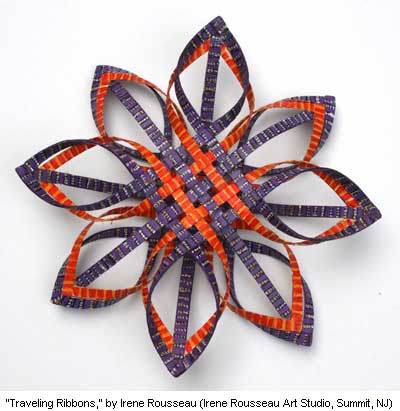
Painted wood and paper collage with gestural expression, 17" x 17" x 5", 2010. The sculpture "Traveling Ribbons"© 2010 is composed of geometric symmetry and interweaving patterns. The alternating overpasses and underpasses at crossings result in graceful curves and transitions between straight and curved sections. The repeating ribbon patterns are arranged in a three-dimensional lattice form and can be viewed from many different directions. The voids between the ribbons become a part of the form and also create a symmetrical pattern. The ribbons are painted in complementary colors of orange and purple with markings, which lead the eye on a continuous path. --- Irene Rousseau
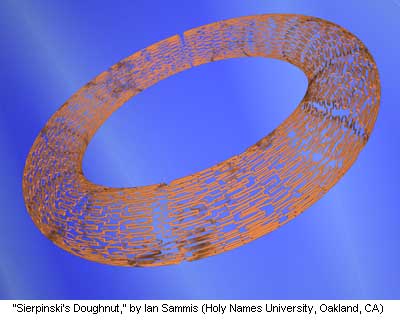
Digital print on canvas, 15" x 12", 2010. A Sierpinksi curve is a space-filling curve that fills a triangle. Sierpinski curves may be chained together to construct a continuous path from triangle to triangle. The correct arrangement of triangles allow the construction of a single path that fills the unit square while following an Eulerian path along a graph with the topology of a torus. Mapping the square onto the torus in the usual way gives us a space-filling closed circuit on the surface of a torus. The image is a render of a tube following such a circuit. --- Ian Sammis

Digital print, 16" x 20", 2008. "Calm" is an artwork based on the "Modularity" concept presented in an article "Modules and Modularity in Mosaic Patterns" (Reza Sarhangi, Journal of the Symmetrion, Volume 19, Numbers 2-3, 2008). Another article in this regard is "Modularity in Medieval Persian Mosaics: Textual, Empirical, Analytical, and Theoretical Considerations" (Sarhangi, R., S. Jablan, and R. Sazdanovic, Bridges Conference Proceedings, 2004). --- Reza Sarhangi (1952-2016)
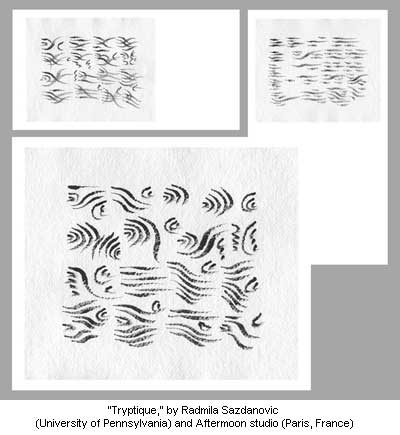
Ink/brush, 24" x 8", 2010. Tryptique is a drawing of three different kinds of diagrams used in categorifications of the one-variable polynomial ring with integer coefficients. These diagrams are elements of three distinct algebras: on the level of Grothendieck rings, projective modules spanned by these diagrams correspond to Chebyshev polynomials, integer powers of $x$ and $(x-1)$, and Hermite polynomials. Asgar Jorn's comment about Pierre Alechinsky's work could as well apply to the signs Aftermoon studio created based on our diagrams. "L'image est écrite et l'écriture forme des images... on peut dire qu'il y a une écriture, une graphologie dans toute image de même que dans toute écriture se trouve une image." --- Radmila Sazdanovic
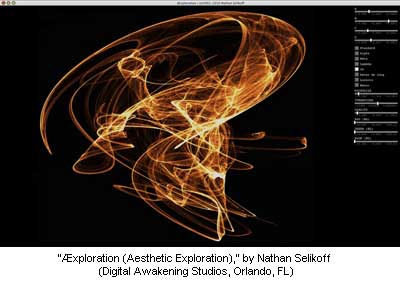
Real-time Video Projection, variable, 2009. Æxploration (Aesthetic Exploration) is a real-time, interactive video projection. This custom software visualizes a variety of two- and three-dimensional strange attractors, allowing the viewer to control the coefficients, color, and translation of the attractor. Until recently, my goal has been to generate high quality still images of strange attractors, and my interactive software has been geared towards that purpose alone - an artist's tool that is a byproduct of the process, viewable only by myself. But recently, in the course of a single day, I made some changes to my code that completely revolutionized what I was seeing on the screen while using my software, and I am excited to share the results. The image above is a screen capture. See the video. --- Nathan Selikoff
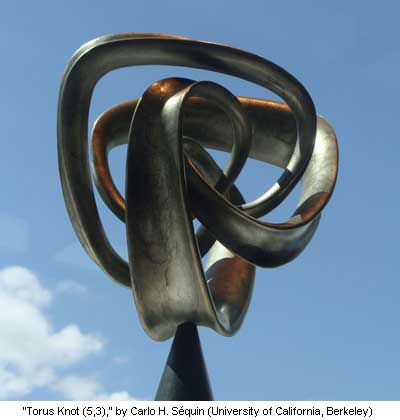
Second Place Award - 2011 Mathematical Art Exhibition
Bronze with silver patina, 10" × 8" × 16", 2010. Torus knots of type $(p,q)$ are simple knots that wind around an invisible donut in a regular manner: $p$ times around the hole, and $q$ times through the hole. By using a somewhat more angular shape for the donut and a variable-size, crescent-shaped cross section for the ribbon, this mathematical construct can be turned into a constructivist sculpture. The challenge was to find a way to make a mold for casting this highly intertwined structure. The solution was to cast three identical pieces, which were then threaded together and welded to each other. --- Carlo H. Séquin
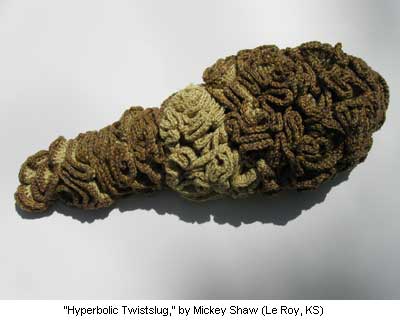
Fiber, 9" x 22" x 13", 2009. This crocheted fiber soft sculpture is based on non-Euclidean geometry. It represents a variation of the hyperbolic plane ruffle effect. The piece was created using basic crochet stitches, which were increased at a rate great enough to create exponential growth. Attention was given to pushing the construction into a form of varying volume, irregular shape and an integration of pattern and color. The end result is simultaneously geometric in its basic nature and organic in its form. This creation used over two pounds of fibers. The structure is malleable, allowing the form to morph into numerous shapes. The hyperbolic soft sculpture is a further exploration of what forms can evolve in combining hard-edged geometric concepts with the fluid, textural aspects of fiber and stitches. This combination creates a three-dimensional visual and mental juxtaposition of the interconnection of the two elements. --- Mickey Shaw
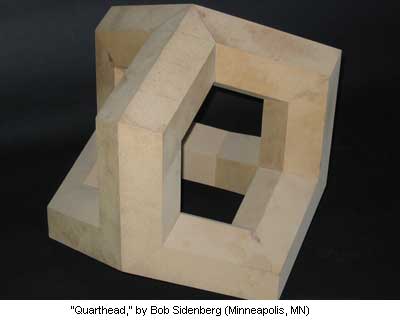
Wood, 16" h x 16" w x 16" d, 2002. This one is trying to be a rhombic dodecahedron, but hasn't quite emerged from its tetrahedral beginnings. --- Bob Sidenberg

Digital print, 20" x 24", 2010. Impossible pentangle construction, 2D and 3D mix-illusion. --- Bente Simonsen
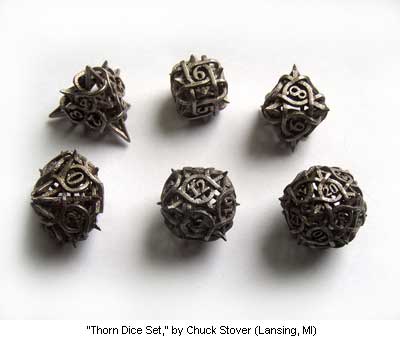
Printed stainless steel and bronze, 6" x 8" x 1", 2010. A set of polyhedral dice with edges defined by interlocking vines of steel. --- Chuck Stover
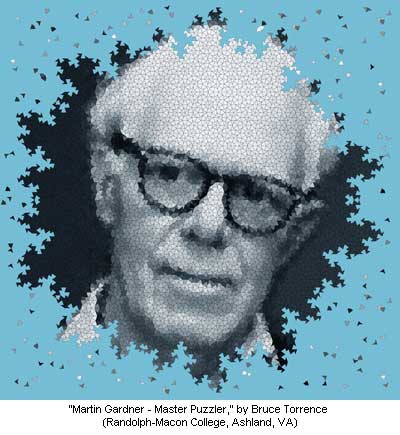
Archival inkjet print, 20" x 20", 2010. This portrait of Martin Gardner (1914-2010) was made by coloring the individual tiles on a kite and dart Penrose tiling. This particular tiling exhibits fivefold rotational symmetry (can you find the center?), and was created by "deflating" a wheel of five kites eight times. Gardner's oft-cited January 1977 Scientific American column introduced the public to Penrose's aperiodic tiles. --- Bruce Torrence
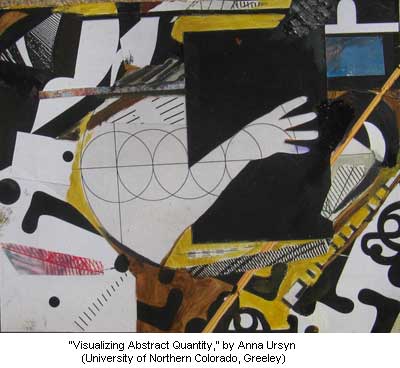
Archival print, 8" x 10", 2010. Unspoken fears. --- Anna Ursyn
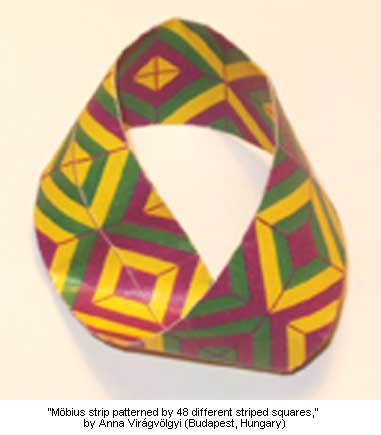
Folded paper, 100 x 100 x 100 mm, 2010. Diagonally striped tiles of this arrangement create concentrically striped squares. The number of squares is the number of all possible triplets of three symbols (no symbols are paired): 3*2*2 = 12. The surface of the Möbius strip is diced with this different 12 squares. The edge of the strip is diced with another whole set of such triplets. This arrangement would be realized on tori as well. --- Anna Virágvölgyi
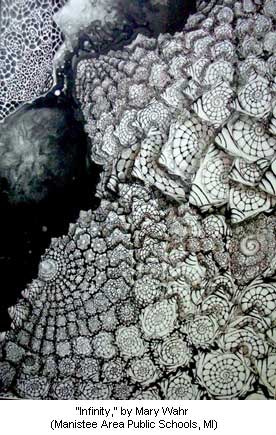
Pen and ink, 18" x 21", 2009. This is an abstract pen and ink rendering of a broccoflower. It is the first piece of art completed for my thesis and was the starting point of two years of research and art. Since my fractal ideas are accomplished without arithmetic, I needed to incorporate the components that define a fractal. This piece of art reflects the concepts of infinity, iteration, self-similarity and scaling. --- Mary Wahr
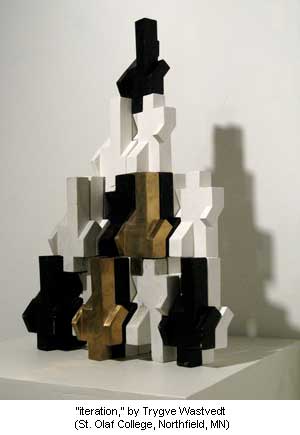
Bronze, plaster, wax, concrete, 18" x 18" x 8", 2010. "iteration" is a series of identical humanoid figures cast in bronze, plaster, wax, and concrete. The form is a near honeycomb so that the individual pieces stack together to fill space. Though geometric, the form still evokes human emotions, which allows the sculpture to ask social and relational questions. --- Trygve Wastvedt
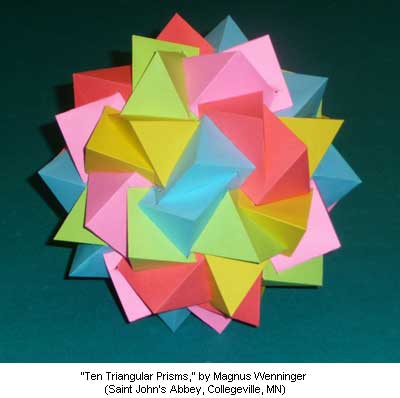
Paper, 9" x 9" x 9", 2010. Robert Webb's Stella program is now the computer program I use for the construction of all the polyhedron models I have recently been making. It is the program par excellence I now use for the discovery of any new polyhedra, especially any I have never made before. The photo shows a model of Ten Triangular Prisms, recently made by me. I found the Stella version on a web page called '75 Uniform Polyhedra' done by Roger Kaufman. It is #32 on this web page. The Stella version gives me a 3D computer view in 10 colors and allows me to choose the size of the model and thus also the size and shape of the net to be used for the construction of the model. However, I wanted my model to be done using only 5 colors. This is where the artwork comes into play. The model now shows each prism with its faces in one color of the five. Thus it becomes uniquely artistic in appearance. --- Magnus Wenninger (1919-2017)



